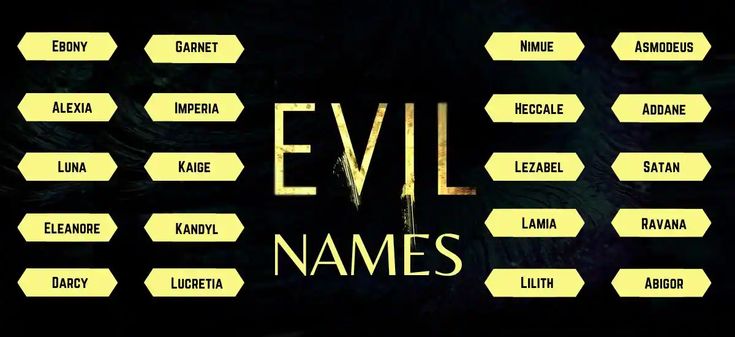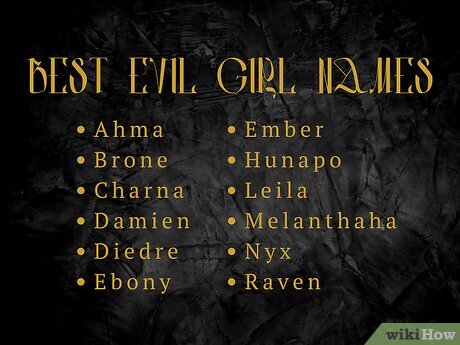Introduction to Evil Names
Names carry immense evil names weight. They are more than just labels — they’re identity markers, storytelling tools, and in many cases, psychological triggers. Among the most fascinating categories of names are those considered “evil.” These are the names we associate with villains, monsters, demons, and dark powers. Whether in books, movies, mythology, or gaming, evil names have an undeniable allure. They instill fear, spark curiosity, and sometimes even admiration. But why are we so drawn to them?
Part of the appeal lies in the human fascination with the unknown and the forbidden. Evil names represent the other side of the coin — the side that heroes must face and overcome. They are the shadows that make the light seem brighter. Additionally, evil names often sound mysterious, powerful, or dangerous, which makes them perfect for crafting memorable characters or evoking certain atmospheres in fiction.
In this article, we’ll explore the origins, construction, and influence of evil names across cultures and media. We’ll also look at how you can create your own sinister names — whether you’re writing a novel, naming a video game villain, or simply satisfying your inner curiosity about the darker side of linguistics.
The Historical Roots of Evil Names
To truly understand the impact of evil names, we have to go back in time — way back to ancient mythology, religious texts, and early storytelling traditions. Evil figures have existed for as long as stories have, and with them came the names meant to invoke fear or caution.
Take “Lucifer,” for example — once a name that meant “light-bringer” in Latin, it became associated with the fallen angel in Christian theology. This transformation from light to darkness is a powerful example of how context can change the perception of a name. Similarly, “Lilith” was originally part of Mesopotamian mythology, depicted as a wind spirit, before evolving into a demonized figure in Judaic folklore. Her name has since become synonymous with female rebellion and darkness.
In Norse mythology, names like “Loki” and “Hel” represent chaos and death, respectively. These names weren’t necessarily evil in the traditional sense, but over time, as stories were retold and reinterpreted, they took on darker connotations. The same goes for “Hades” in Greek mythology — a god of the underworld whose name now evokes dread, despite his relatively neutral role in myth.
Even in ancient languages, certain sounds and letter combinations were associated with malevolence. Harsh consonants, like K, X, Z, or Q, were often used in names that were meant to strike fear. That trend has continued in modern villain naming conventions.

The Psychology Behind Evil-Sounding Names
There’s actually a bit of science Evil names behind why some names sound more evil than others. Linguistically, certain phonetic patterns are more likely to be associated with danger, aggression, or mystery. For instance, names with hard stops (like “Krang” or “Vlad”) tend to sound more abrupt and threatening. Names that use less common letters (like Z, Q, or X) also tend to stand out, giving them an exotic and dangerous edge.
Think of names like “Voldemort” from Harry Potter, “Sauron” from The Lord of the Rings, or “Maleficent” from Sleeping Beauty. All of these names were carefully crafted to sound dark and powerful. “Voldemort” literally means “flight of death” in French. “Maleficent” derives from the Latin maleficentia, meaning “doing evil.” These aren’t accidental choices — they tap into our subconscious associations.
Interestingly, even without any knowledge of a character’s backstory, we often intuitively judge names as “good” or “evil” just by how they sound. That’s the power of phonosemantics — the study of how sound influences meaning. It’s why names like “Grimhilda,” “Zarok,” or “Mortis” just feel sinister.
Evil Names in Pop Culture and Fiction
Evil names have become a staple in literature, movies, comics, video games, and television. These names aren’t just meant to label villains — they’re designed to define them. A great evil name does more than identify a character; it creates an atmosphere, a mood, and an expectation.
In fantasy, evil names are often rooted in ancient or pseudo-languages. Think “Morgoth” and “Gul’dan.” These names sound like they’ve been around for millennia — they carry the weight of dark history. In sci-fi, names like “Darth Vader” or “Thanos” evoke technological menace or raw power. Comic book villains like “Dr. Doom” and “Red Skull” wear their evil right in their names — no subtlety needed.
One reason these names work so well is because they’re often paired with the character’s actions and appearance. The name “Bellatrix Lestrange” (from Harry Potter) might not sound obviously evil to a child, but once the character’s cruelty and madness are revealed, the name becomes terrifying by association.
Moreover, many of these names have found their way into popular culture outside their original contexts. People use “Voldemort” as a reference to anyone seen as manipulative or power-hungry. This reuse of evil names in everyday speech gives them even more cultural power.
How to Create Your Own Evil Names
If you’re a writer, game designer, or storyteller, crafting an evil name can be one of the most enjoyable parts of world-building. There’s no one-size-fits-all formula, but here are some techniques to keep in mind:
1. Use Harsh Sounds:
Evil names often use hard consonants like K, G, V, Z, and X. Examples include “Karnax,” “Zulgrim,” or “Varkor.” These sounds feel unnatural or aggressive, which suits dark characters.
2. Tap into Ancient or Foreign Roots:
Latin, Greek, Norse, Slavic, and even constructed languages can provide sinister-sounding roots. Combining Latin words like mort (death), nox (night), or malus (bad) can create cool names like “Mortivar” or “Noxira.”
3. Add Titles or Epithets:
A simple name can be made more evil with the right title. “Azarion the Cruel,” “Queen Sythra of the Abyss,” or “Lord Baelgrath, Bringer of Shadows” immediately sets a tone.
4. Keep It Pronounceable:
While complexity can be cool, if a name is too difficult to pronounce, readers may disengage. Aim for a balance between exotic and accessible.
5. Play with Juxtaposition:
Sometimes, giving a dark character a beautiful name can create disturbing contrast. A villain named “Seraphina” or “Elias” might seem gentle at first — until the darkness is revealed.
Evil Names Across Different Cultures
Every culture has its own set of “evil” names tied to folklore, legends, or spiritual beliefs. In Islamic tradition, names like “Iblis” (the devil figure) carry deep religious and moral weight. In Japanese mythology, names like “Oni” or “Yurei” are linked with demons and spirits. In Hindu lore, figures like “Ravana” and “Asura” are complex antagonists, often with great power and intellect.
African mythology features names like “Legba” or “Anansi” — trickster deities who walk the line between good and evil. In Slavic folklore, “Baba Yaga” is a name that sparks both fear and intrigue. Each of these names reflects the moral framework and storytelling traditions of their culture.
Understanding these cultural lenses is important when using or adapting evil names from around the world. Names that might sound cool in one context could carry unintended connotations in another, especially if they stem from sacred or sensitive traditions.
The Modern Appeal of Evil Names
In today’s world, evil names aren’t just for storytelling — they’re part of branding, identity, and even internet culture. You’ll find gamers adopting names like “DarkslayerX,” “VoidQueen,” or “NecroLord” to convey a certain image. Social media handles, gamer tags, and even online businesses sometimes lean into dark aesthetics to stand out.
There’s also a growing trend of “likable villains” — characters whose evil names are matched by charisma, intelligence, or relatable motives. These names become iconic because they capture the nuance of modern villainy. Think of names like “Killmonger,” “Loki,” or “Homelander.” They’re morally complex, and their names add to that mystique.
Interestingly, some parents even name their children after fictional villains, drawn by the strength or uniqueness of the name — although this remains controversial, especially when the name is overtly linked to dark historical figures.
Conclusion:
Evil names are more than just spooky-sounding words. They’re storytelling tools, cultural markers, and psychological triggers that continue to evolve with time. Whether rooted in ancient myths or crafted for futuristic villains, these names have a timeless grip on our imaginations.
Their power lies not just in how they sound, but in what they represent — mystery, danger, rebellion, and the eternal struggle between light and dark. And while good names may comfort us, it’s the evil ones that often linger in memory the longest.
So whether you’re looking to write the next great villain, explore dark folklore, or just indulge in some gothic wordplay, don’t underestimate the power of a good evil name. After all, sometimes darkness speaks louder when it has the perfect name.





